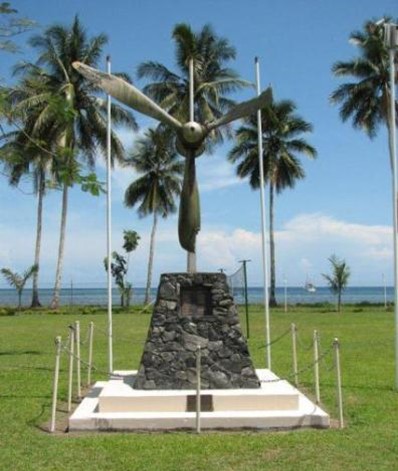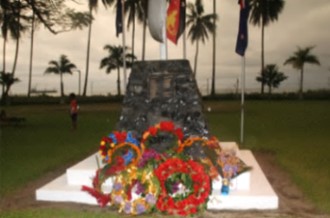
PNGAA Library
Anzac Day, San Remo Club, 2012: Cecilie Benjamin

The following speech was made at the San Remo Club, West New Britain, on Anzac Day 2012
 We gather today here at the San Remo Club, as we annually have in recent years, to pause and reflect on the past history when war engulfed this country and the tragic consequences which ensued.
We gather today here at the San Remo Club, as we annually have in recent years, to pause and reflect on the past history when war engulfed this country and the tragic consequences which ensued.
This year, being 2012, marks a milestone. It is now 70 years since the horrors of WW2 impacted Papua New Guinea. The Japanese Imperial Forces had invaded Rabaul in January 1942 in defiance of the League of Nations Mandate set over New Guinea. The resulting 3 and a half years of savage conflict saw not only the deaths of thousands of military personnel from Allied and Axis forces alike but deep impacts on local communities caught in the middle of events initiated far beyond their shores.
Australian forces based in Rabaul, both Army and Air, were forced into a desperate retreat which saw their soldiers and administration pushed back along the north and south coasts of this very large island of New Britain. To the majority of the Australian military struggling to survive in such a withdrawal, the foreign environment they moved through appeared a hostile and formidable place.
Australian soldiers escaping along the north coast were gathered up by Talasea ADO, Keith McCarthy, who took charge of the evacuation. They were eventually brought to Iboki via Baia, Tarobi, Koimumu, Walindi Plantation and Garu Mission by walking, canoes and small sea craft. Waiting for a boat to take them to safety, Mrs Gladys Baker, the then owner of Langu Plantation on Witu Island described the scene, "A steady stream of sick, hungry, ill-clad men started to arrive at Iboki until 250 civilians and soldiers collected there: most were in a bad way with tropical ulcers, malaria, and dysentery." McCarthy commandeered the boat MV Lakatoi which had been sheltering at Witu and evacuated the group. It was March 1942.
At a parallel time, the infamous Tol and Gasmata massacres occurred to fleeing Australian troops on the South Coast of this island by Japanese forces.
It was two more long years of raging air warfare to follow until Allied ground troops landed in late December 1943 at Cape Gloucester.
The impact and enormity was felt heavily on the local coastal populations of New Britain particularly. Stories of that time will still abound around village fires in the evenings even to this day. Recently, I was visiting the West Willaumez Peninsular and arrived at the village of Bagum. While sitting with community elders prior to a formal meeting, without any prompting and being a relatively unknown entity to the community, one man told me about the day WW2 came to their shore. He was talking about the landing of an American PT boat during the night in March 1944 when a young man, Australian Coastwatcher Rod Marsland, was part of a reconnaissance unit with the USMC 1st Division. The American Marines had taken Iboki after a major battle for Cape Gloucester resulted in defeat for the Japanese Imperial Army. The Japanese were in full retreat up the north coast of New Britain by land having been given a sock of rice and told to walk back to Rabaul by their Command.
The stealth recon was to evaluate the best landing site for the US Marines and Volupai was chosen as that site. Rod Marsland made contact with people he had known in his plantation days in the Talasea area but will always be remembered for the message he carried. He told his trusted friends at Bagum to pass the message to all the villages along the West Willaumez Peninsular right down to Kambili and Garu to urgently move away south from the Peninsular as a big fight was about to occur with aerial bombings and shooting. His heroic action and message saved lives in the coastal communities and is still remembered today. The communities didn't ever forget.
If any of you gathered here today saw the recent epic HBO mini-series The Pacific, tracing the USMC's 1st Division 3rd Battalion 5th Regiment K Company war time experiences in the Pacific from Guadalcanal in The Solomon Islands, New Britain PNG, Peleliu in Palau and Okinawa, Japan, you may be familiar with some of the true characters in that series such as RV Burgin, Captain Ack Ack Haldane, Merriel (Snafu) Shelton, Gunnery Sergeant Haney and the 235 men of K Company. I realised that this same Company which was the focus of the series had conducted what came to be known as "The Numundo Patrol" after the US Marine landing at Volupai. I decided to try to contact RV Burgin, a Texan, personally and gain his first hand recollection about this time and events in our locality. Within two days, through a series of contacts, I had his phone number and an arranged time to call. The call to his Texas home resulted in an intense hour long conversation concerning "The Numundo Patrol".
His recollection of the events here were crystal clear. It was as if they had happened yesterday and not those which had occurred almost 70 years prior. He is a man with a most lively sense of humour. He knew Rod Marsland though not personally as Rod was embedded with their K Company during and after the Volupai landings. The Numundo Patrol was estimated to take 3 days from Bitokara Catholic Mission to near where Numundo Plantation offices stand today. It didn't work that way. The Patrol ended up taking 10 days and each day K company was ambushed and often under attack from hidden machine guns around water sources. Men died. The Japanese units were led by Captain Terenuma fighting a delaying action in order for struggling, sick and starving Japanese soldiers abandoned by their Commander to retreat from Cape Gloucester and pass through the base of the Willaumez Peninsular heading for Garbubu (Gavuvu) their Hoskins base. The last battle for the USMC on New Britain occurred at Kilu village at an area named "Tanga Na Wor" in Bakovi or in English, "Place of War" on 16 March 1944.
RV Burgin vividly remembered the Papua New Guineans who carried the ammunition for this patrol and who equally came under fire and attack. He recalled vividly the young boy with a machete tied to his waist skimming up a coconut tree to get drinking coconuts and other observations. Recently, Brent Weibe, a missionary who spent 16 years studying, recording and translating the Bakovi language into the bible, told me a Kilu man had not long ago found a Samurai Sword defiantly planted in the ground in some uncleared bush near the village church. Still, the events of 70 years ago are being played out in our communities.
Many of the Japanese soldiers who were captured in the awful retreat from Cape Gloucester were sent to Cowra POW camp in Australia and died in the Cowra Break Out.
I asked RV Burgin about the plantations they passed through and did they remember Walindi Plantation next to where they battled in Kilu Village. He said they passed through many plantations long abandoned and areas were in terrible economic decay in The Solomon Islands and on New Britain. This gave me an idea. I endeavoured to retrace the steps of RV Burgin’s Numundo Patrol from 1944. Returning to Bitokara Catholic Mission, and the beautiful site overlooking the islands off Talasea, I photographed the church, still standing from that WW2 period. K Company had camped in fox holes in front of it in the middle of a big wet season. Proceeding down the road I photographed the village oil palm projects, community owned cocoa/coconut plantings, the NBPOL plantations employing thousands of the countries citizens and exporting PNG's premier agricultural export earner, Kilu Water Supply Project bringing water to households and eliminating the need for women to carry heavy loads for their families daily use, Walindi Plantation Resort with visitors from so many nations including former bitter foes who now sit at the one table for an evening meal, Mahonia Na Dari Marine Research, Education and Conservation Centre educating future PNG generations about the wonders of their precious environment, Numundo Beef and the fat cattle in the feed lot. RV Burgin, being a Texan, would appreciate images of healthy cattle I was sure. Photos of the good road built by Dumez Construction followed the same bush track K Company would have fought along.
So, from war to peace in 70 years for our locality and communities and the proof is visible for all to view. RV Burgin was happy to see in the images sent the results of what he and many thousands of others during WW2 basically fought for: a peace where people can get on with their lives and be free to do so.
Whoever it was who said those who have no knowledge of their history are doomed to repeat the mistakes of the past spoke some powerful and wise words. It is basically the reason we are here today and gather to commemorate those who lost their lives in terrible conflicts such as WW1 and WW2 to give us the freedom we enjoy today.
Lest we forget

Photo: Jeni Spargo